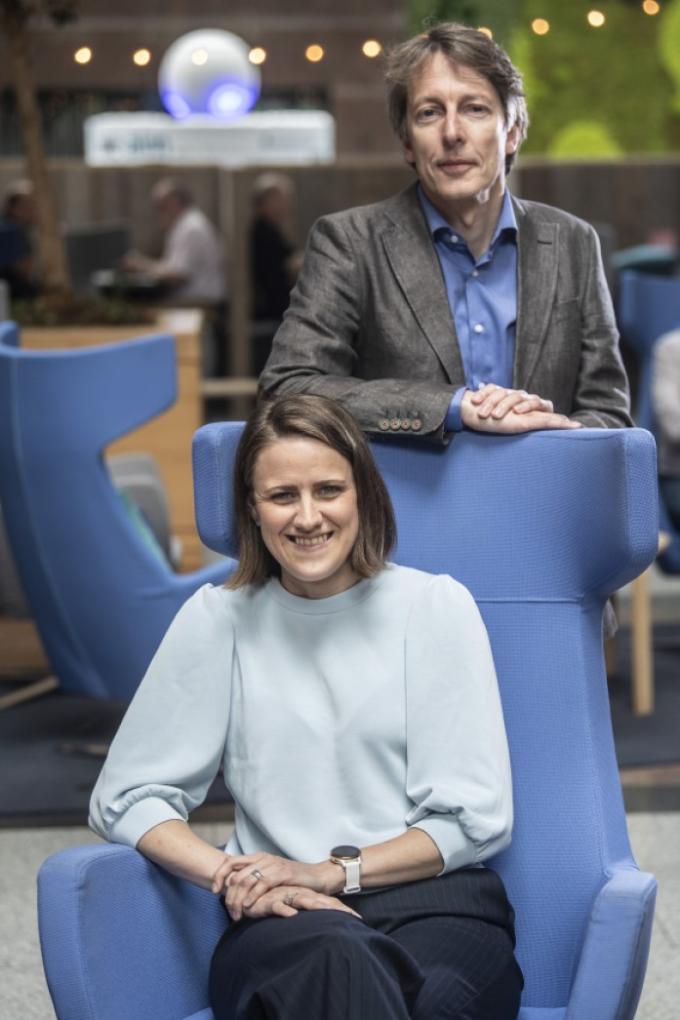Robots have no problem picking orders in the dark
In order to retain the "Made in Europe" label, European companies must work ever faster, more accurately and more cheaply. This can be done by fully focusing on innovation, say Dirk Sebrechts and Sabrina Reynen, both portfolio managers at KBC Asset Management.

“China is banging on the high-tech industry’s door." Sebrechts says. "In the automotive industry in particular, the country has already positioned itself as a key player. If competition from China involves unfair trade practices, trade barriers obviously need to be established, but it is just as important for Europe to maintain its technological edge through innovation.”
What innovations will allow Europe to achieve faster, cheaper and more accurate production processes? “Automation is driving the industry forward,” says Sebrechts, who has noticed various European companies jumping on board the automation train, such as the French Schneider Electric, which specialises in energy management and digital automation, German tech giant Siemens, and the Swedish industrial group Atlas Copco whose headquarters are in Antwerp. “Atlas Copco, for instance, supplies compressors that are essential for dust-free production in the semiconductor industry – in fact, crucial to quality in the pharmaceutical industry, too. Companies like that are key to maintaining a competitive edge.”
Fewer defects and less waste
More and more work, across all sectors, is performed by sophisticated robots. According to market research firm MarketsandMarkets, the industrial robotics market is valued at 17 billion dollars worldwide and is projected to reach double that amount by 2028. Robots can work in dangerous or uncomfortable conditions, such as high temperatures, noise or pollution, without getting tired or making mistakes. Because they are meticulous in their work, defects and waste are kept to a minimum, and they can efficiently switch between tasks.
Technology is designed to complement humans rather than replace them: you still need highly skilled engineers and IT professionals to operate the machines. Finding the right people for these jobs is already posing a challenge for the European industry.
Dirk Sebrechts, portfolio manager KBC Asset Management

Automation and robotics don’t necessarily mean replacing humans. “We will always need humans to operate the machines”, says Sebrechts. “Technology is often designed to complement humans. When robots are used in surgery, they don’t replace the surgeon but enable more precise manoeuvres. The same goes for the industry. Cars used to be tested by placing a clay model of the car in a wind tunnel; nowadays, they can be tested in virtual simulations using technology from software suppliers such as Dassault Systèmes.”
This combination of humans and machines requires highly skilled engineers and IT professionals. “Finding the right people for these jobs is already posing a challenge for the European industry, prompting temp agencies like Randstad and data suppliers like Wolters Kluwer to take action”, says Sebrechts.
Reynen has noticed this quest for talent in the area of student housing, too. “Real estate investment fund Xior Student Housing, for example, is specialised in this area in Belgium. There is a serious shortage in student accommodation. When a company like Xior builds 500 student digs, they’re rented out in no time.”
Smart logistics and warehousing
Europe wants to regain control over production. Some 47% of all European companies are actively engaged in reindustrialisation or ‘reshoring’. But what is the most efficient and sustainable way to transport these locally produced goods? And where do we store them?
Thanks to smart logistics, more and more warehouses are fully automated and sustainable, allowing static buildings to transform into dynamic ecosystems.
Sabrina Reynen, portfolio manager KBC Asset Management

Smart logistics provide an efficient solution, for instance for the joint management of orders and routes across transport systems. As a result, extra-long trucks are used more and more, which means more load behind one engine. Their final destination: warehouses with autonomous, real-time inventory management.
“New warehouses are equipped with the latest technology, from temperature control and in-house power supply to charging infrastructure for electric trucks. Static buildings are being transformed into dynamic ecosystems”, says Reynen. “In the US, logistics real estate giant Prologis builds warehouses for the likes of Amazon, Fedex and Walmart, where human intervention has even been completely eliminated. And since robots can pick orders in the dark, it’s energy-efficient, too.”
MarketsandMarkets estimated the automated logistics market at 32.7 billion dollars last year, and expects it to reach 51.2 billion dollars by 2028. These figures are realistic given the high-performance products and technologies driving smart logistics. The key technology is the industrial Internet of Things, a network of connected devices, machines and systems that collect, exchange and analyse data in real time. “This can significantly reduce the error rate and save costs”, says Reynen. “It also enables predictive maintenance of machines based on event-log analysis.”
Benefiting from ‘Made in Europe’

Customers and investors benefit from the ‘Made in Europe’ label. This certification offers them more transparency about the products they buy and everything associated with them, such as composition, production and quality. Since all ‘Made in Europe’ companies are subject to the same policies and regulations, all the products they sell in the EU are subject to the same level of conformity.
The quality and safety standards set and imposed on companies by the EU also boost consumer and investor confidence in these companies. So it’s a win-win situation: it improves the company’s image, and consumers and investors can rely on a certain standard. “Our products may remain more expensive in Europe, but if we deliver high-quality as well as more sustainable products, customers might just be willing to pay more for products produced locally in Europe”, concludes Sebrechts.
This article is purely informative and should not be considered investment advice.
